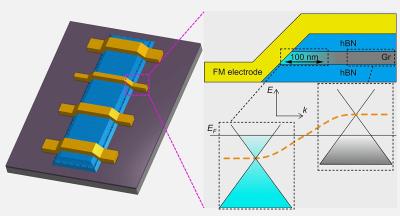Researchers at The University of Manchester and Japan's National Institute for Materials Science seem to have made a significant step towards quantum computing, demonstrating step-change improvements in the spin transport characteristics of nanoscale graphene-based electronic devices.

The team used monolayer graphene encapsulated by another 2D material (hexagonal boron nitride) in a so-called van der Waals heterostructure with one-dimensional contacts. This architecture was reported to deliver an extremely high-quality graphene channel, reducing the interference or electronic âdopingâ by traditional 2D tunnel contacts.
In their new work, the team measured electron mobility up to 130,000cm2/Vs at low temperatures (20K or -253oC). For purposes of comparison, the only previously published efforts to fabricate a device with 1D contacts achieved mobility below 30,000cm2/Vs, and the 130k figure measured by the team is higher than recorded for any other previous graphene channel where spin transport was demonstrated.
The researchers also recorded spin diffusion lengths approaching 20μm. Where longer is better, most typical conducting materials (metals and semiconductors) have spin diffusion lengths
Lead author of the study Victor Guarochico said: âOur work is a contribution to the field of graphene spintronics. We have achieved the largest carrier mobility yet regarding spintronic devices based on graphene. Moreover, the spin information is conserved over distances comparable with the best reported in the literature. These aspects open up the possibility to explore logic architectures using lateral spintronic elements where long-distance spin transport is needed.â
Co-author Chris Anderson added: âThis research work has provided exciting evidence for a significant and novel approach to controlling spin transport in graphene channels, thereby paving the way towards devices possessing comparable features to advanced contemporary charge-based devices. Building on this work, bilayer graphene devices boasting 1D contacts are now being characterized, where the presence of an electrostatically tunable bandgap enables an additional dimension to spin transport control.â